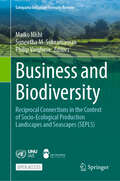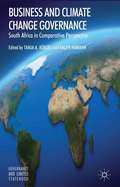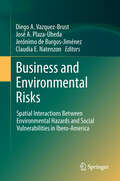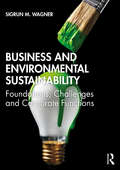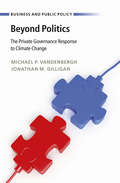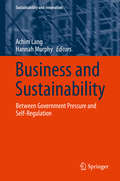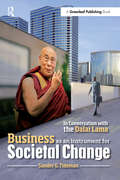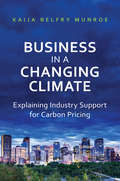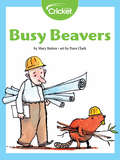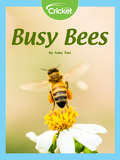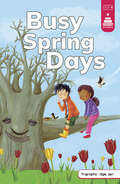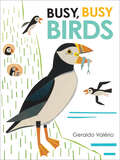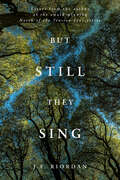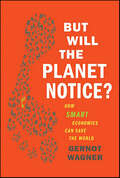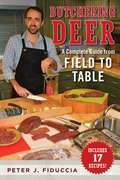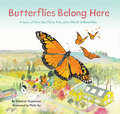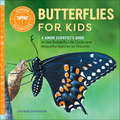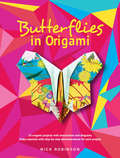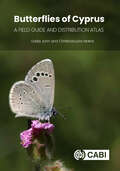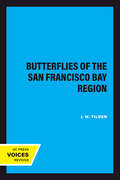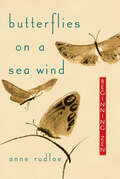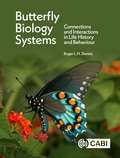- Table View
- List View
Business and Biodiversity: Reciprocal Connections in the Context of Socio-Ecological Production Landscapes and Seascapes (SEPLS) (Satoyama Initiative Thematic Review)
by Maiko Nishi Suneetha M. Subramanian Philip VargheseThis open access book presents useful knowledge and lessons that derive from on-the-ground activities and contributes to policy recommendations, focusing on the reciprocal connections between business and biodiversity in the context of social-ecological production landscapes and seascapes (SEPLS). It introduces a set of concrete examples demonstrating the relevance of SEPLS to aspects of reciprocal connections between business and biodiversity. The case studies highlight the roles, attitudes, motivations, and actions of multiple stakeholders in conserving biodiversity while providing other benefits that directly or indirectly contribute to businesses. They also illustrate on-the-ground impacts of businesses in SEPLS – including positive and negative ones, providing insights on how to categorize and measure the impacts and dependency of businesses on biodiversity and nature’s contributions to people. This will help facilitate policy learning and evidence-based decision-making to promote the achievement of global goals including the Kunming-Montreal Global Biodiversity Framework and the sustainable development goals (SDGs). Many of the case studies concerning SEPLS management derived from the International Partnership for the Satoyama Initiative (IPSI) provide rich evidence to detail and help clarify the interdependency between businesses and biodiversity while exemplifying innovative solutions to facilitate more sustainable business decisions and actions for socially and ecologically sound outcomes. Furthermore, the experiences in managing SEPLS where multiple actors negotiate and collaborate to meet diverse needs and interests provide practical insights on the roles and responsibilities of stakeholders and how to build partnerships to promote systemic changes towards sustainable futures. The book provides key messages derived from a synthesis of the case study findings, which will help stakeholders including policymakers, scientists, and practitioners to deepen the understanding of reciprocal connections between business and biodiversity and clarify challenges and opportunities for promoting more sustainable businesses and at the same time safeguarding biodiversity and ecosystems. This in turn will help further the science-policy-practice interfaces related to biodiversity, ecosystem services, and sustainable development.
Business and Climate Change Governance
by Tanja BorzelHow and why do business organisations contribute to climate change governance? The contributors' findings on South Africa, Kenya and Germany demonstrate that business contributions to the mitigation and adaptation to climate change vary significantly.
Business and Environmental Risks: Spatial Interactions Between Environmental Hazards and Social Vulnerabilities in Ibero-America
by Diego A. Vazquez-Brust Claudia E. Natenzon Jerónimo de Burgos-Jiménez José A. Plaza-ÚbedaBased on detailed research funded across two continents and involving universities in Argentina, Spain and the UK, this book sets out an innovative, multidisciplinary approach to assessing both environmental and social risks in a given territorial area. Using data from a number of Ibero-American nations, the study combines environmental, socio-economic and geographic factors to construct a set of spatial and technical indicators that measure the social vulnerability and industrial hazardousness of a defined area. Aggregating these indicators in a geographic information system (GIS) allows researchers to assess the potential risk to which a certain area and its population are subject as a result of the environmental deterioration caused by co-located industrial activity.
Business and Environmental Sustainability: Foundations, Challenges and Corporate Functions
by Sigrun M. WagnerEnvironmental sustainability is increasingly important to organisations, whether for regulatory, financial or ethical reasons. Business and Environmental Sustainability looks at the environmental aspect of sustainability for all organisations pursuing competitive advantage. The book provides theoretical foundations from science, economics, policy and strategy, introduces three environmental challenges (climate change, pollution and waste) and looks at how corporate functions can address these. This textbook provides a thorough foundation by introducing readers to the science, reasoning and theory behind environmental sustainability and then delves into how these ideas translate into principles and business models for organisations to use. Next, it covers environmental challenges from climate change, pollution and waste, and then goes on to examine the different corporate functions (from supply chain management to human resources) to illustrate how environmental sustainability is managed and put into practice in organisations. Finally, a set of integrative case studies draws everything together and enables the reader to apply various analytical tools, with the aim of understanding how companies can not only reduce their environmental footprint but can positively contribute to environmental sustainability. Written by an award-winning lecturer, Business and Environmental Sustainability boasts a wealth of pedagogical features, including examples from a range of industries and countries, plus a companion website with slides, quiz questions and instructor material. This will be a valuable text for students of business, management and environmental sustainability and will also be suitable for broader courses on corporate responsibility and sustainability across environmental studies, political science and engineering.
Business and Public Policy: The Private Governance Response to Climate Change (Business and Public Policy)
by Michael P. Vandenbergh Gilligan Jonathan M.Private sector action provides one of the most promising opportunities to reduce the risks of climate change, buying time while governments move slowly or even oppose climate mitigation. Starting with the insight that much of the resistance to climate mitigation is grounded in concern about the role of government, this books draws on law, policy, social science, and climate science to demonstrate how private initiatives are already bypassing government inaction in the US and around the globe. It makes a persuasive case that private governance can reduce global carbon emissions by a billion tons per year over the next decade. Combining an examination of the growth of private climate initiatives over the last decade, a theory of why private actors are motivated to reduce emissions, and a review of viable next steps, this book speaks to scholars, business and advocacy group managers, philanthropists, policymakers, and anyone interested in climate change.
Business and Sustainability: Between Government Pressure and Self-Regulation (Sustainability and Innovation)
by Achim Lang Hannah MurphyDemands for sustainability policies have set new challenges for business both on the individual firm level and on the level of organized business interests. This edited volume brings together economic, social, environmental, and cultural dimensions of sustainability that comprise different challenges for business processes and activities. The aim is to develop an overarching framework to the study of sustainability and business and to advance an interdisciplinary analytical perspective. The book establishes a balanced account that equally represents business as problem causers as well as problem solvers, and therefore responds to the urgent need to investigate the intersection between sustainability issues and business participation.
Business as an Instrument for Societal Change: In Conversation with the Dalai Lama
by Sander TidemanBusiness as an Instrument for Societal Change: In Conversation with the Dalai Lama is the result of two decades of research and dialogue with His Holiness the Dalai Lama and other leaders in business, government, science and education. Author Sander Tideman, a lawyer and banker who has maintained a friendship with the Dalai Lama over all these years, presents a practical framework and methodology to develop a new kind of leadership - one fit to repurpose the business world and tackle escalating social, economic and environmental needs. The Dalai Lama rarely speaks directly on the topics of business, leadership and economics. Yet in the dialogues recounted here, his wisdom - combined with key insights from business and public leaders -creates a unified shift towards a consciousness of interconnectedness, offering profound insights for practitioners and general readers alike. Tideman unites the scientific worldviews of physics, neuroscience and economics with the positive psychology of human relationships, and ancient spiritual wisdom, to formulate practical business leadership solutions. While recognizing the need for change in external structures and governance, Tideman highlights the importance of opening our minds, and connecting inner and outer spirituality. At the same time, he focuses on concrete practices for winning the hearts and minds of employees, customers, communities, and society at large, while addressing deep-rooted problems such as extreme social inequality and continued financial collapses. At the heart of this book lies the journey to discover our shared purpose. This ignites new sources of value creation for the organisation, customers and society, which Tideman terms 'triple value'. We can achieve triple value by aligning societal and business needs, based on the fundamental reality of interconnection. Business as an Instrument for Societal Change: In Conversation with the Dalai Lama is a readable and intelligent exploration of how leaders can actually help to shape a sustainable global economy by embracing innate human and humane behaviour. It is also Tideman's fascinating personal journey, which brought him to question the underlying motivations and goals of business leadership and to seek a new paradigm for a more sustainable approach. Reflecting Tideman's sharp perceptions and infused with the Dalai Lama's unmistakable joy, this book has the power to change your way of thinking.
Business in a Changing Climate: Explaining Industry Support for Carbon Pricing
by Kaija Belfry MunroeClimate change skeptics and business pundits alike are convinced that any public policy instruments used to curtail environmental degradation are antithetical to the interests of the corporate community. However, many companies have actually come out in favour of carbon pricing. In Business in a Changing Climate, Kaija Belfry Munroe examines this counterintuitive action and, in doing so, explains how large firms determine their preferences for public policy options. Her analysis of thirteen industrial associations and seventeen firms from industries such as petrochemical, forestry, mining, and steel, reveals that, despite the higher costs, these industries prefer carbon pricing over voluntary agreements. Based on enlightening interviews with executives, government, and NGO officials, Belfry Munroe argues that the acceptance of climate change policy by companies is determined by the risks posed to capital investments and investor concern. Business in a Changing Climate is the first book to ask major pollution emitting industries in Canada what their preferences are with respect to climate change.
Busy Bees
by Amy TaoBees pollinate the flowers of the plants we eat. Without pollination, plants can't grow fruits and seeds. Which foods would you miss if we didn't have honeybees? So next time you're eating a meal, stop and thank the bees for their hard work!
Busy Penguins
by John Schindel Jonathan ChesterThe beloved Busy Animals board book series has an irresistible new look!These busy penguins are dashing, splashing, jumping, bumping, and going about their busy penguin lives. Young children will love to imitate the many actions the penguins are doing, while the vivid, full-color photographs will keep them engaged time after time. Join in the fun!From the Board edition.
Busy Spring Days (Stairway Decodables Step 4)
by Leanna KochSpring is here, and it is busy! From new buds on tree branches to baby birds in nests, spring brings things back to life. Come along as Leela and Reed explore the many changes of the season. Stairway Decodables is a supplemental phonics resource that’s perfect for supporting small group instruction, independent reading, or reading practice at home. This title provides practice in decoding words with the trigraphs spr and dge.
Busy, Busy Birds
by Geraldo ValérioThis lively board book introduces young ones to a colorful collection of very busy birds. These birds are busy! Most of our feathered friends fly, but what about the ones that soar or strut, paddle or perch? Explore the kinetic lives of birds through captivating collage illustrations, filled with bright colors and strong shapes. Playful text will introduce infants and toddlers to a variety of verbs, making this a fun read-aloud for bird lovers of all ages. Key Text Features labels illustrations
But Still They Sing
by J. F. RiordanA new book of essays from award-winning author J.F. Riordan records a natural world minutely observed. From a bathtub spider to a tree-borne cluster of cold raccoons, the collection captures the peculiar isolation and intensity of pandemic lockdown. Deeply insightful and personal, by turns soulful and humorous, these meditations on life and grief belong at the bedside of anyone in search of the comfort and companionship of a humane voice.
But Will the Planet Notice?: How Smart Economics Can Save the World
by Gernot WagnerYou are one of seven billion people on Earth. Whatever you or I do personally—eat tofu in a Hummer or hamburgers in a Prius—the planet doesn't notice. In our confrontation with climate change, species preservation, and a planet going off the cliff, it is what several billion people do that makes a difference. The solution? It isn't science, politics, or activism. It's smarter economics. The hope of mankind, and indeed of every living thing on the planet, is now in the hands of the dismal science. Fortunately, we've been there before. Economists helped crack the acid rain problem in the 1990's (admittedly with a strong assist from a phalanx of lawyers and activists). Economists have helped get lead out of our gas, and they can explain why lobsters haven't disappeared off the coast of New England but tuna is on the verge of extinction. More disquietingly, they can take the lessons of the financial crisis and model with greater accuracy than anyone else the likelihood of environmental catastrophe, and they can help save us from global warming, if only we let them.
Butchering Deer: A Complete Guide from Field to Table
by Peter J. FiducciaYou’ve had a successful day in the field. Now what? Expert Peter Fiduccia has all the information you need to prepare deer in his new book, Butchering Deer. Fiduccia starts with the history of hunting deer for meat, the nutritional content of venison, and deer anatomy for better shot placement. He then extensively covers all phases of field dressing and butchering, from eviscerating the animal and skinning hides to how to cut each piece of meat (chuck, rib, short loin, loin end, rump, round, shank, flank, plate, brisket, shoulder, shank, and even bacon and ham). Other topics include: Tag it & drag it: transporting deer from field to home Protecting the carcass from bugs How to prepare a clean working area Tips to grinding burger and sausage meat Guidelines for packaging, labeling, and freezing Sharpening knives and other butchering tools Dry rubs and marinades And many more! The butchering sections include detailed photos and drawings depicting all sections of meat to butcher. Fiduccia concludes his guide with a section on the best ways to prepare and cook venison in camp or at home using quick and easy recipes. With Butchering Deer, you can easily become a home deer butcher.
Butterflies Belong Here: A Story of One Idea, Thirty Kids, and a World of Butterflies
by Deborah HopkinsonButterflies Belong Here is a powerful story of everyday activism and hope.In this moving story of community conservation, a girl finds a home in a new place and a way to help other small travelers.This book is about the real change children can make in conservation and advocacy—in this case, focusing on beautiful monarch butterflies.• From Deborah Hopkinson and Meilo So, the acclaimed team behind Follow the Moon Home• An empowering, classroom-ready read• The protagonist is a girl whose family has recently immigrated to the United States.I know what to look for: large black-and-orange wings with a border of small white specks, flitting from flower to flower, sipping nectar. But though I looked hard, I couldn't find even one. I wondered if monarch butterflies belonged here. I wondered if I did, too.Butterflies Belong Here is proof that even the smallest of us are capable of amazing transformations.• Equal parts educational and heartwarming, this makes a great book for parents and grandparents, as well as librarians, science teachers, and educators.• Those interested in beautiful butterflies and everyday activism will find this lovely book both motivating and inspiring.• Perfect for children ages 5 to 8 years old• You'll love this book if you love books like Thank You, Earth: A Love Letter to Our Planet by April Pulley Sayre, The Honeybee by Kirsten Hall, and Greta and the Giants: Inspired by Greta Thunberg's Stand to Save the World by Zoë Tucker
Butterflies for Kids: A Junior Scientist's Guide to the Butterfly Life Cycle and Beautiful Species to Discover (Junior Scientists)
by Lauren DavidsonExplore the wonderful world of butterflies with the Junior Scientist series for kids ages 6 to 9 Have you ever wondered how chubby caterpillars transform into beautiful, graceful butterflies? Or why some butterflies have bright, colorful wings while others look plain? Butterflies for Kids answers all your questions with fascinating facts, photos, and illustrations. Learn about the butterfly life cycle, their unusual behaviors, and impressive migrations. You'll even find tips for attracting butterflies to your backyard and using a kit to raise your own!This standout among butterfly books for kids includes:The complete life cycle—Discover how caterpillars grow, what happens inside a chrysalis, how butterflies find mates, and how they stay safe out in the wild.Backyard butterfly profiles—Learn all about 32 different butterflies commonly found in North America, including monarchs, swallowtails, painted ladies, and more.Stats and facts—Explore where and when you can spot different butterflies, what they like to eat, and other fun facts that make each species unique.Take a journey through the lives of butterflies with Butterflies for Kids!
Butterflies in Origami
by Nick RobinsonOrigami master Nick Robinson presents 20 delightful butterfly models for folders at every level of experience. In this easy-to-follow guide, he offers fold-by-fold instructions that are fully illustrated with color photos and diagrams.Models include such real-life species as the Maniola jurtina, or meadow brown. You'll also find a butterfly bursting from its cocoon, a caterpillar, an envelope with a butterfly, and other imaginative possibilities. Each project is graded according to difficulty.
Butterflies of Cyprus: A Field Guide and Distribution Atlas
by Eddie John Christodoulos MakrisThis new book summarises decades of research and collation of distributional data. From the tiny Freyeria trochylus (Grass Jewel), Europe's smallest butterfly, to the magnificent, newly arrived Papilio demoleus (Lime Swallowtail), this comprehensively illustrated reference book and field guide includes all butterfly species known in Cyprus over the past 100 years. Where applicable, reference is made to subspecies of related taxa present in nearby countries of the eastern Mediterranean. The images on the cover represent the island's seven endemics, discussed in depth. Included, too, are detailed distribution maps representing records garnered from almost 300 recorders/sources (particularly members of the Cyprus Butterfly Study Group), over a period of more than 20 years.
Butterflies of the Pacific Northwest (A Timber Press Field Guide)
by Robert Michael Pyle Caitlin LaBarA comprehensive field guide to the butterflies of the Pacific Northwest from renowned experts Easy to use and beautifully illustrated with more than 600 color photographs and nearly 200 maps, Butterflies of the Pacific Northwest is a must-have for nature lovers in Washington, Oregon, western Idaho, northern California, and British Columbia. The profiles include preferred common name for both genus and species, type locality, conservation status, the look and distinguishing traits of each butterfly, the preferred foodplants and nectar plants, habitat and range, and much more. Additional information includes a brief introduction to how butterflies work and details on ecology and conservation.
Butterflies of the San Francisco Bay Region (California Natural History Guides #12)
by J. W. TildenThis title is part of UC Press's Voices Revived program, which commemorates University of California Press’s mission to seek out and cultivate the brightest minds and give them voice, reach, and impact. Drawing on a backlist dating to 1893, Voices Revived makes high-quality, peer-reviewed scholarship accessible once again using print-on-demand technology. This title was originally published in 1965.
Butterflies on a Sea Wind: Beginning Zen
by Anne RudloeThis memoir by a marine biologist &“sings the life of a beginning Zen practitioner. . . . [with] a haunting, beautiful appreciation of the natural world.&”(Publishers Weekly) Anne Rudloe was attracted to Zen as a college student. But it seemed premature for a twenty-one-year-old to focus on the difficulties of life when she'd hardly begun to live. Twenty-five years later, she was ready to explore the spiritual discipline that originated in Asian monasteries more than a millennium ago. Rudloe's quest is compellingly chronicled in Butterflies on a Sea Wind, which combines the rigor of formal monastic Zen practice with the challenges of integrating Zen concepts into modern daily life. Her narrative describes both the physical and mental demands of Zen retreats and how she applied what she learned there to her work as a marine biologist in Florida, as well as to the rigors of raising children and caring for an elderly grandmother. In words that intimately draw in her readers, she describes how Zen helps us look inward and use the wisdom we find there to reach out to others. During the 1990s, the number of organized Buddhist centers in this country grew more than 40 percent, from 429 to 1,062. While there are many books about Zen on the market today, few give a clear picture of what it's like to actually sit down and begin a meditation practice and then apply it to a daily life. Likewise, few books discuss the types of issues most people face every day: raising a family and earning a living. Butterflies on a Sea Wind does all this and more.
Butterflies on a Sea Wind: Beginning Zen
by Anne RudloeThis memoir by a marine biologist &“sings the life of a beginning Zen practitioner. . . . [with] a haunting, beautiful appreciation of the natural world.&”(Publishers Weekly) Anne Rudloe was attracted to Zen as a college student. But it seemed premature for a twenty-one-year-old to focus on the difficulties of life when she'd hardly begun to live. Twenty-five years later, she was ready to explore the spiritual discipline that originated in Asian monasteries more than a millennium ago. Rudloe's quest is compellingly chronicled in Butterflies on a Sea Wind, which combines the rigor of formal monastic Zen practice with the challenges of integrating Zen concepts into modern daily life. Her narrative describes both the physical and mental demands of Zen retreats and how she applied what she learned there to her work as a marine biologist in Florida, as well as to the rigors of raising children and caring for an elderly grandmother. In words that intimately draw in her readers, she describes how Zen helps us look inward and use the wisdom we find there to reach out to others. During the 1990s, the number of organized Buddhist centers in this country grew more than 40 percent, from 429 to 1,062. While there are many books about Zen on the market today, few give a clear picture of what it's like to actually sit down and begin a meditation practice and then apply it to a daily life. Likewise, few books discuss the types of issues most people face every day: raising a family and earning a living. Butterflies on a Sea Wind does all this and more.
Butterfly Biology Systems: Connections and Interactions in Life History and Behaviour
by Roger L DennisIn Butterfly Biology Systems Roger Dennis explores key topics and contentious issues in butterfly biology, specifically those in life history and behaviour. Uniquely, using a systems approach, the book focuses on the degree of integration and feedback between components and elements affecting each issue, as well as the links between different issues. The book comprises four sections. The first two sections introduce the reader to principles and approaches for investigating complex relationships, and provide a platform of knowledge on butterfly biology. The final two sections deal in turn with life history and behaviour, covering key issues affecting different stages of development from eggs to adults. The book is extensively illustrated with original diagrams and models, all of which have detailed legends, produced to enhance a broader understanding, and to provide templates for future research. It includes a detailed bibliography and glossary providing an essential gateway to the extensive literature on butterfly biology. Butterfly Biology Systems is essential reading for graduate students and researchers in insect ecology, evolution, behaviour and conservation. It will also be of great value to anyone interested in butterflies. Introduces a systems approach to butterfly biology Includes succinct reviews of the key interrelationships in butterfly life history and behaviour Illustrates more than 100 models to advance research into butterfly biology systems
